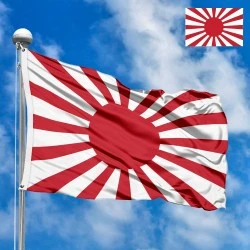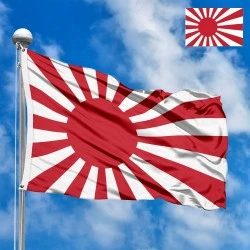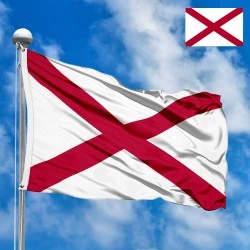Flag of Japan
- Flag Type: State
- Proportions (official): 2:3
- Official name: Japan
- Local name: 日本国 (Nippon-koku)
- Sovereignty (year): YES (1952)
- Member of Organizations: UN
- Country code, territory: JP, JPN, 392
- Capital: Tokyo
- Large cities: Yokohama, Osaka, Nagoya
- Population: ~122,500,000 (2024, MIC)
- Religions: Shinto/Buddhism ~80%
- Area (km²): 377 975
- Highest point: Mount Fuji (3,776 m)
- Lowest point: Hachirogata (-4 m)
- Currency: Japanese yen (JPY, ¥)
- Languages: Japanese
- Dialing code: +81
- National domain: .jp
Flag Information
General information
Demography and Culture
Economy and communications
- All Flags
- Flags of Countries by Continent
-
Flags of Organizations
- Flags of UN countries
- Flags of the European Union countries
- Flags of NATO countries
- Flags of the countries of the Organization of Islamic Cooperation
- Flags of the countries of the Organization of American States
- Flags of the Arab League countries
- Flags of the African Union countries
- Flags of the countries of the Union of South American Nations
- Flags of the Commonwealth of Nations
- Flags of the countries of the Secretariat of the Pacific Community
- Flags of the Nordic Council countries
- Flags of the Caribbean Community
- Flags of the countries of the Association of Southeast Asian Nations
- Flags of the East African Community
- Flags of the countries of the Organization of Turkic States
- LGBT Community Flags
- Historical Flags
- Ethnic Flags
- Flags of the USA (states)
Description
The National Flag of Japan, universally known as the Hinomaru (日の丸), meaning "circle of the sun," is a symbol of profound simplicity and immense national pride. Its minimalist design belies a rich tapestry of history, mythology, and cultural significance that resonates deeply with the Japanese people. Far more than just an emblem of state, the Hinomaru embodies the nation's identity as the "Land of the Rising Sun" and its enduring values. Understanding its elements, history, and meaning offers a captivating window into the heart of Japan.
A Visual Symphony: Description, Dimensions, and Element Arrangement
The Hinomaru features a white rectangular field with a large crimson-red disc positioned precisely in the center. The white background traditionally symbolizes purity, honesty, and integrity, values deeply cherished in Japanese society. The crimson-red disc, the focal point of the flag, represents the sun. This imagery is rooted in Japan's ancient origins and its mythological connection to the sun goddess Amaterasu Ōmikami, believed to be the ancestress of the Japanese imperial line. The sun's prominence on the flag reflects Japan's traditional designation as the "Land of the Rising Sun," a name that evokes a sense of enlightenment and the dawn of a new era.
The design of the Hinomaru is meticulously proportioned. The ratio of the flag's height to its length is 2:3, a standard proportion for many national flags, ensuring visual balance and ease of reproduction. The crimson-red disc itself is positioned exactly in the center of the white field, and its diameter is three-fifths (3/5) of the flag's height. These precise specifications, codified in the Act on National Flag and National Anthem of 1999, ensure consistency and proper display of this revered national symbol. The red is a deep, rich crimson, often described as a vibrant, intense red, contrasting sharply yet harmoniously with the pure, stark white.
Echoes of Time: The History of the Flag's Creation
The origins of the Hinomaru are steeped in antiquity and folklore, rather than a singular moment of creation. The concept of the sun as a central symbol for Japan dates back centuries, if not millennia. Legend has it that the flag's design was presented to the Emperor of Japan by a Buddhist monk during the Mongol invasions of the 13th century, to be used as a rallying point for the samurai. While this story is likely apocryphal, it highlights the flag's long association with national defense and imperial authority.
Historical records indicate that variations of the "sun disc" flag were used by Japanese warlords and naval forces as early as the 16th century. During the Edo period (1603-1868), the flag was primarily used by the Tokugawa shogunate's ships. However, it was not until the Meiji Restoration in 1868 that the Hinomaru officially began its journey to becoming the national emblem. On January 27, 1870, by a proclamation of the Grand Council of State, the sun disc flag was officially adopted as the national flag for merchant ships. This was a crucial step as Japan began to engage more formally with the international community, requiring a clear national identifier for its vessels.
Over the subsequent decades, the Hinomaru gradually gained acceptance as the de facto national flag for other purposes as well. It was widely used by the Imperial Japanese Army and Navy, and its image became deeply ingrained in the national consciousness, particularly during the period of imperial expansion in the early 20th century. Despite its widespread use, there was no specific law formally designating it as the national flag for all purposes until the late 20th century.
The formal legal adoption of the Hinomaru as the national flag came with the Act on National Flag and National Anthem (国旗及び国歌に関する法律, Kokki oyobi Kokka ni Kansuru Hōritsu), passed on August 13, 1999. This act officially codified the design, dimensions, and usage of the Hinomaru, along with the national anthem, Kimigayo. The passage of this law, though controversial for some who associated the flag with Japan's militaristic past, aimed to provide clear legal standing for these national symbols in modern Japan.
Japan's Identity Woven in Fabric: Significance for the Nation
The Hinomaru holds profound significance for Japan, embodying its historical continuity, cultural identity, and spiritual connection to nature. It visually articulates the nation's ancient myths, particularly its link to the sun goddess Amaterasu, from whom the imperial family is believed to descend. This deep historical root gives the flag a sacred quality for many.
For the Japanese people, the flag represents their national pride, unity, and resilience. It is a symbol of their shared heritage, their unique culture, and their place in the world. Despite its simple design, it evokes a powerful sense of belonging and collective identity. The flag is displayed prominently on public buildings, schools, and during national holidays and sporting events, fostering a sense of community and patriotic sentiment. It symbolizes Japan's post-war pacifism and its commitment to peace, having transformed from a symbol associated with imperial ambitions to one representing a modern, democratic nation.
Intriguing Facets: Interesting Facts about the Hinomaru
-
Ancient Origins: While officially adopted in 1870 (for merchant ships), variations of the sun disc motif have been used for centuries, possibly as early as the 7th century, by emperors and warlords.
-
"Land of the Rising Sun": The design directly reflects Japan's traditional name, Nippon (日本), which literally means "origin of the sun" or "where the sun rises."
-
Simplicity and Power: The Hinomaru is renowned for its minimalist design, making it one of the simplest yet most recognizable national flags in the world. Its simplicity lends it a timeless and powerful aesthetic.
-
The Kimigayo Connection: The 1999 Act on National Flag and National Anthem formally recognized both the Hinomaru and the Kimigayo, Japan's national anthem, as official national symbols. This was a significant step in codifying symbols that had long been used but lacked formal legal status.
-
Controversies: Despite its widespread acceptance, the Hinomaru (and Kimigayo) has been a subject of controversy for some, particularly among those who associate it with Japan's imperialistic and militaristic past leading up to and during World War II. Debate continues regarding its compulsory display in schools.
-
Usage in Space: The Hinomaru was famously carried by Japanese astronauts into space, notably by Mamoru Mohri aboard the Space Shuttle Endeavour in 1992, symbolizing Japan's scientific and technological achievements on the global stage.
-
Cultural Representation: Beyond official use, the Hinomaru is frequently seen in Japanese art, pop culture, and sports, demonstrating its deep integration into the everyday lives and national identity of the Japanese people.
The Moment of Formalization: Adoption and Reception
While the Hinomaru had been used de facto as the national flag for many decades, its formal legal adoption occurred with the passage of the Act on National Flag and National Anthem on August 13, 1999. This act formally defined its design, proportions, and official status. Prior to this, its use was largely based on custom and a proclamation from 1870 for merchant ships.
The passage of the 1999 law was a significant event, as it addressed a long-standing omission in Japanese law regarding its national symbols. The debate surrounding its adoption was complex, reflecting differing views within Japanese society about its historical connotations. However, for the government and many citizens, it was seen as a necessary step to officially define national symbols in a modern, post-war context. The reception was generally one of formal recognition and affirmation of a symbol that was already deeply embedded in the national consciousness. While some groups expressed dissent due to historical associations, for the majority, it was a confirmation of a beloved and well-recognized national emblem.
A Beacon of Identity: Meaning for Residents
For the people of Japan, the Hinomaru is far more than a mere national emblem; it is a profound symbol of their heritage, unity, and aspirations. It embodies their identity as a nation that values purity, integrity, and resilience. The white field represents the honesty and moral rectitude that are central to Japanese ethics, while the vibrant red disc symbolizes the energy, vitality, and pioneering spirit of the "Land of the Rising Sun."
The flag evokes a strong sense of belonging and continuity with an ancient and revered past. It reminds them of their shared cultural values, their collective strength in overcoming adversity (such as natural disasters or post-war reconstruction), and their harmonious relationship with nature, particularly the venerated sun. Despite historical controversies, for the vast majority, the Hinomaru is a source of unquestionable national pride, representing a peaceful, prosperous, and culturally rich nation. It is a visual testament to their unique identity on the global stage, a symbol that unites them in celebration and in times of challenge, always reflecting the enduring spirit of Japan.
In the demonstration images, full-size flags are shown with proportions of 2:3, and hand-held flags with proportions of 1:2.
Donation
Download
Completely free for commercial and non-commercial use (public domain).
You can freely use them in your news magazines, websites, software, mobile applications.
We appreciate a backlink to https://flagssite.com
Raster files - Flag of Japan (PNG, JPG)
 Waving flag
Waving flag
- PNG format (transparent background), 72dpi, dimensions in Pixels (px), aspect ratio 3:4.
- 15х20 px
- 30х40 px
- 60х80 px
- 120x160 px
- 240x320 px
 Sizes:
Sizes:
"v15" - image size (by height); if necessary, replace with available: v15, v30, v60, v120, v240.
!!! For resizing, use the Latin (eng) keyboard layout.
<img src="https://flagssite.com/flags/v15/20348.png" alt="Flag of Japan">
 Round flag
Round flag
- PNG format (transparent background), 72dpi, dimensions in Pixels (px), aspect ratio 1:1.
"d15" - image size (diameter); if necessary, replace with available: d15, d30, d60, d120, d240.
!!! For resizing, use the Latin (eng) keyboard layout.
<img src="https://flagssite.com/flags/d15/20348.png" alt="Flag of Japan">
 Rectangular flag 2:3
Rectangular flag 2:3
- JPG format, 72dpi, dimensions in Pixels (px), aspect ratio 2:3.
"h30" - image size (by height); if necessary, replace with available: h15, h30, h60, h120, h240, h360, h480.
!!! For resizing, use the Latin (eng) keyboard layout.
<img src="https://flagssite.com/flags/h30/20348.jpg" alt="Flag of Japan">


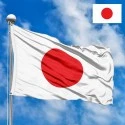
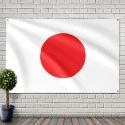
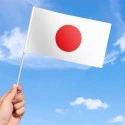

 Sizes:
Sizes:
 Sizes:
Sizes:
